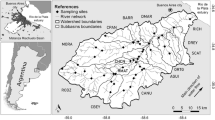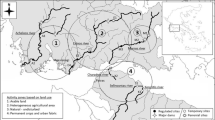Abstract
A benthic macroinvertebrate and sediment chemistry study of the St. Clair River from Lake Huron to Lake St. Clair was conducted in the spring of 1985. The purpose of the. study was to evaluate the environmental quality of the nearshore areas and assess the effectiveness of industrial and municipal abatement programs that have been implemented since 1977.
A total of 112 macroinvertebratd taxa was collected from the river. Classification analysis indicated that 7 macroinvertebrate communities were evident in the river. Discriminant analysis suggested that physical habitat characteristics explained the distribution of 4 benthic communities, while sediment contaminants explained the distribution of 3 benthic communities. These analyses showed that the environmental quality of a 12 km stretch of the river along the Canadian shoreline had been degraded, probably by industrial waste discharges and spills. Toxic conditions were evident along the waterfront of Dow Chemical Canada Inc., probably a result of the combined effects of chlorinated organics, oils and greases, and mercury (historical contaminant) in the sediments. In contrast, the invertebrate fauna throughout the remainder of the St. Clair River reflected meso-eutrophic conditions, typical of a large, unstressed river.
A comparison of the environmental quality as reflected by the benthic invertebrate fauna in 1985 with that in 1977 suggests that the abatement programs implemented over the past decade have improved the environmental quality along the Canadian side of the river. The total length of river adversely affected by waste discharges from Canadian industries and municipalities decreased from 21 km in 1977 to 12 km in 1985.
Similar content being viewed by others
References
Brinkhurst, R. O. & D. G. Cook, 1974. Aquatic earthworms. In: C. W. Hart Jr. & S. L. H. Fuller (eds). Pollution Ecology of Freshwater Invertebrates. pp. 143–155. Academic Press, New York.
Brinkhurst, R. O., A. L. Hamilton & H. B. Herrington, 1968. Components of the bottom fauna of the St. Lawrence Great Lakes. Great Lakes Inst., Univ. Toronto. PR 33: 1–49.
Britt, N. W., 1955. Stratification in western Lake Erie in the summer of 1953: effects on the Hexagenia population. Ecology 36: 239–244.
Carr, J. F. & J. K. Hiltunen, 1965. Changes in the bottom fauna of western Lake Erie from 1930 to 1961. Limnol. Oceanogr. 10: 551–569.
Chan, C. H., Y. L. Lau & B. G. Oliver, 1986. Measured and modelled chlorinated contaminant distributions in the St. Clair River water. Wat. Pollut. Res. J. Can. 21: 332–343.
Cook, D. G. & M. G. Johnson, 1974. Benthic macroinvertebrates of the St. Lawrence Great Lakes. J. Fish. Res. Bd Can. 31: 763–782.
Cuffney, T. F., J. B. Wallace & J. R. Webster, 1984. Pesticide manipulation of a headwater stream: Invertebrate response and their significance for ecosystem processes. Freshwat. Invert. Biol. 3: 153.
Derecki, J. A., 1984. St. Clair River physical and hydraulic characteristics. Ntnl. Oceanic Atmos. Admin., Great Lakes Env. Res. Lab. Open File Report. Ann Arbor, Michigan. 8 pp.
EC & OME (Environment Canada & Ontario Ministry of the Environment), 1986. St. Clair River pollution investigation (Sarnia Area). Report of the Review Board of the Canada-Ontario Agreement Respecting Great Lakes Water Quality. Ottawa, Canada 135 pp.
EC & US EPA (Environment Canada & U.S. Environmental Protection Agency), 1989. Upper Great Lakes Connecting Channels Study — Volume 2, 626 pp.
Edsall, T. A., B. A. Manny & C. N. Raphael, 1988. The St. Clair River and Lake St. Clair, Michigan: an ecological profile. U.S. Fish Wildl. Serv., Biological Report 85 (7.3). Ann Arbor, Michigan. 130 pp.
Gauch, H. G. Jr., 1979. Compclus. Ecology and systematics, Cornell Univ., Ithaca, New York. 59 pp.
Gauch, H. G. Jr., 1982. Multivariate Analysis in Community Ecology. Cambridge Univ. Press, Cambridge. 298 pp.
Goodnight, C. J. & L. S. Whitley, 1960. Oligochaetes as indicators of pollution. In: Proc. 15th Indust. Waste Conf, Purdue Univ. pp. 139–142.
Green, R. H., 1979.Sampling Design and Statistical Methods for Environmental Biologists. John Wiley and Sons Inc., New York. 257 pp.
Griffths, R. W., 1978. Benthic communities as indicators of water quality in the St. Clair River. B.Sc. Thesis. Univ. Western Ont., London, Ontario, Canada. 40 pp.
Griffiths, R. W., 1987. Environmental quality assessment of Lake St. Clair in 1983 as reflected by the distribution of benthic invertebrate communities. Ont. Min. Env., London, Ontario, Canada. 35 pp.
Griffiths, R. W., 1989. The effect of in-place pollutants on the benthic invertebrate fauna of the Spanish River harbour. Ont. Min. Env., Sudbury, Ontario, Canada. 27 pp.
Grzenda, A. R., G. J. Lauer & H. P. Nicholson, 1964. Water pollution by insecticides in an agricultural river basin. II. The zooplankton, bottom fauna and fish. Limnol. Oceanogr. 9: 318–323.
Harman, W. N., 1974. Snails. In: C. W. Hart Jr. & S. L. H. Fuller (eds), Pollution Ecology of Freshwater Invertebrates. pp. 143–155. Academic Press, New York.
Harrel, R. C., 1985. Effects of a crude oil spill on water quality and macrobenthos of a southeast Texas stream. Hydrobiologia 124: 223–228.
Henderson, C., 1949. Value of the bottom sampler in demonstrating the effects of pollution on fish-food organisms and fish in the Shenandoah River. Progress. Fish-Cult. 11: 217–230.
Hilsenhoff, W. L., 1982. Using a biotic index to evaluate water quality in streams. Dept. Ntrl. Res., Tech. Bull. No. 132. Madison, Wisconsin. 22 pp.
Hudson, P. L., B. M. Davis, S. J. Nichols & C. M. Tomcko, 1986. Environmental studies of macrozoobenthos, aquatic macrophytes and juvenile fishes in the St. Clair-Detroit River system, 1983–1984. U.S. Fish Wildl. Serv., Great Lakes Fish. Lab. Admin. Rep. 86–7. Ann Arbor, Michigan. 116 pp.
Hynes, H. B. N., 1961. The effect of sheep dip containing the insecticide BHC on the fauna of a small stream including Simulium and its predators. Ann. Trop. Med. Parasit. 55: 192–196.
Hynes, H. B. N., 1970. The Ecology of Running Waters. Liverpool Univ. Press. Liverpool, England. 555 pp.
IJC (International Joint Commission), 1982. 1982 Report on Great Lakes Water Quality. Prepared by the Great Lakes Water Quality Board. Windsor, Ontario, Canada. 153 pp.
Keenleyside, M. H. A., 1967. Effects of forest spraying with DDT in New Brunswick on food of young Atlantic salmon. J. Fish. Res. Bd Can. 24: 107.
Lauritsen, D. D., S. C. Mozley & D. S. White, 1985. Distribution of oligochaetes in Lake Michigan and comments on their use as indices of pollution. J. Great Lakes Res. 11: 67–76.
Legendre, L. & P. Legendre, 1983. Numerical Ecology. Elsevier Sci. Publ. Co., Amsterdam. 419 pp.
Merritt, R. W., K. W. Cummins & T. M. Burton, 1984. The role of aquatic insects in the processing and cycling of nutrients. In: V. H. Resh & D. M. Rosenberg (eds), The Ecology of Aquatic Insects. pp. 134–163. Praeger Publishers, New York.
Oliver, B. G. & C. W. Pugsley, 1986. Chlorinated contaminants in the St. Clair River sediments. Wat. Pollut. Res. J. Can. 21: 368–379.
OME (Ontario Ministry of Environment), 1979. St. Clair River organics study: Biological surveys 1968 and 1977. Southwestern Region, Water Resources Assessment Unit. London, Ontario, Canada. 90 pp.
OME, 1983. Handbook of analytical methods for environmental samples. Lab. Serv. Br., Rexdale, Ontario, Canada.
OME, 1985. A guide to the collection and submission of samples for laboratory analysis. 5th ed. Lab. Serv. Br., Rexdale, Ontario, Canada.
OME, 1986a. Drinking water survey, St. Clair-Detroit River area. Update August 1986. Wat. Resources Br., Toronto, Ontario, Canada. 20 pp.
OME, 1986b. Report of the 1985 discharges from municipal wastewater treatment facilities in Ontario. Wat. Resources Br., Toronto, Ontario, Canada. 241 pp.
Pennak, R. W., 1978. Freshwater Invertebrates of the United States. 2nd edn. J. Wiley and Sons, New York. 803 pp.
Pinder, L. C. V. & F. Reiss, 1983. The larvae of Chironomidae of the Holarctic Region. Keys and diagnoses. Entomol. Scand. Suppl. 19: 293–435. Lund, Sweden.
Quinn, F. H. & R. N. Kelly, 1983. Great Lakes monthly hydrologic data. Ntnl. Oceanic Atmos. Admin. ERL GLERL-26. Ann Arbor, Michigan. 79 pp.
Rabeni, C. F., S. P. Davies & K. E. Gibbs, 1985. Benthic invertebrate response to pollution abatement: Structural changes and functional implications. Wat. Res. Bull. 21: 489–497.
Roback, S. S., 1962. Environmental requirements of tricoptera. In: Biological problems in water pollution. Third Seminar. U.S. Dept. health, Educ. Welf. Public Health Serv. Publ. No. 999-WP-25. 1965. 424 pp.
Saether, O. A., 1977. Taxonomic studies on Chironomidae: Nanocladius, Pseudochironomus and the Hamischia complex. Bull. Fish. Res. Bd Can. 196. Ottawa, Ontario, Canada. 143 pp.
Saether, O. A., 1979. Chironomid communities as water quality indicators. Holarctic Ecol. 2: 65–74.
Soluk, D. A., 1985. Macroinvertebrate abundance and production of psammophilous chironomidae in shifting sand areas of a lowland river. Can. J. Fish. aquat. Sci. 42: 1296–1302.
Thornley, S., 1985. Macrozoobenthos of the Detroit and St. Clair rivers with comparisons to neighbouring waters. J. Great Lakes Res. 11: 290–296.
Warwick, W. F., 1980. Palaeolimnology of the Bay of Quinte, Lake Ontario: 2800 years of cultural influence. Can. Bull. Fish. aquat. Sci. 206. 117 pp.
Wiederholm, T., 1984. Responses of aquatic insects to environmental pollution. In: V. H. Resh & D. M. Rosenberg (eds), The Ecology of Aquatic Insects. pp. 508–557. Praeger Publishers, New York.
Williams, W. T. & J. M. Lambert, 1959. Multivariate methods in plant ecology. J. Ecol. 47: 83–101.
Winnel, M. H. & D. J. Jude, 1984. Associations among chironomidae and sandy substrates in nearshore Lake Michigan. Can. J. Fish. aquat. Sci. 41: 174–179.
Author information
Authors and Affiliations
Rights and permissions
About this article
Cite this article
Griffiths, R.W. Environmental quality assessment of the St. Clair River as reflected by the distribution of benthic macroinvertebrates in 1985. Hydrobiologia 219, 143–164 (1991). https://doi.org/10.1007/BF00024752
Issue Date:
DOI: https://doi.org/10.1007/BF00024752




